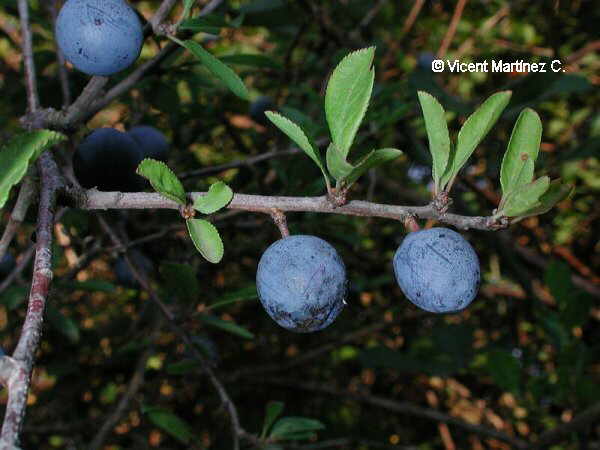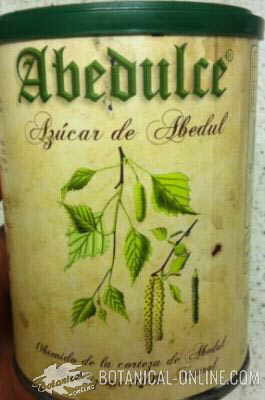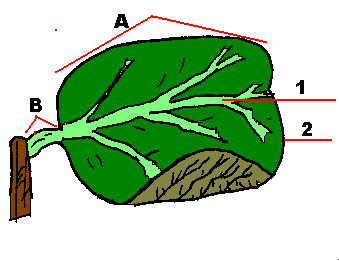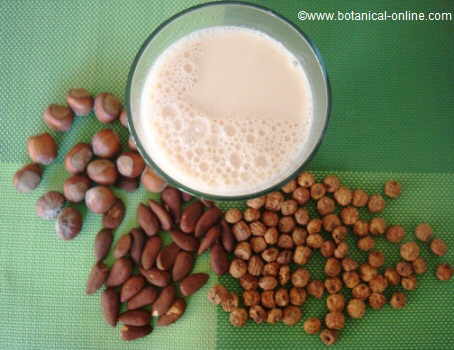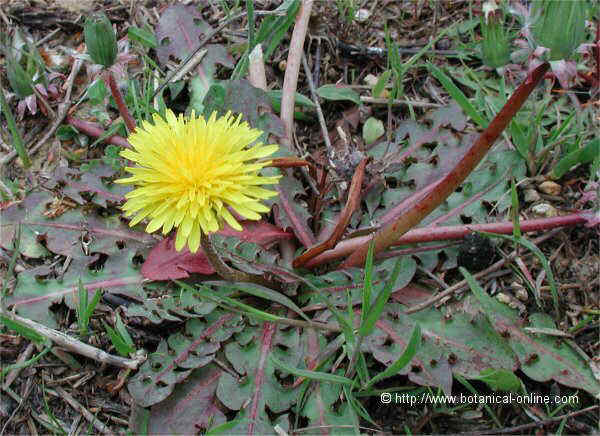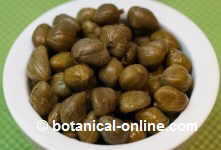Contents
How to grow holm oaks
HOLM OAK GROWING TIPS
Holm oak. Characteristics:
Perennial tree of the Fagaceae family up to 20 m. Erect stems of gray color, short and tortuous. Leaves alternate, coriaceous, elliptical, oblong or lanceolate, bright green above, not pubescent, and with whitish pubescence underside, up to 4 cm in length, with up to 11 pairs of lateral nerves, and very variable margins (whole, dentate or even thorny)
Yellowish flowers, gathered in inflorescences in the form of dangling catkins of tender shoots of the year. Nucular fruit, (this is what is known as an acorn), dark brown at maturity, bitter, inedible, 1 to 3 cm in length and with the dome that does not reach half. It blooms in spring and its fruits ripen in autumn.
Holm oak. Irrigation:
The littoral variety (Quercus ilex L. subsp.ilex) requires a greater amount of water.
No need to water once established if the weather is rainy because it has enough rainwater. It prefers annual precipitation averages of 600 or 700 liters per year, provided that the soil is deep and its roots can reach areas with remaining moisture.
In superficial soils, or located on slopes or rocky slopes, they would need 700 to 1200 liters each year.
It should be watered a couple of times a month during the first 4 years of planting during the summer and once a month in the spring.
In case of planting in drier areas, it is advisable to use the holm oak variety Quercus ilex L. subsp. rotundifolia that can live with a very low amount of water. (There are continental holm oaks that present very good appearance with an average of 300 liters of annual precipitation)
Many times it is planted under cypress grass. In this case it is necessary to take special care that the cypresses do not get wet when watering them.
Holm oak uses
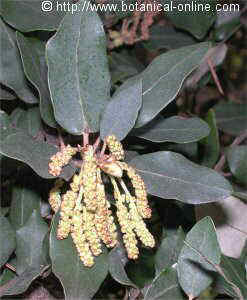
Holm oak catkins of flowers in spring
These are tthe main apllications of holm oak trees:
- Holm oak for Landscaping: Holm oaks are large trees that should be planted in gardens, squares or streets. Since it supports pruning very well, they can be planted in large or relatively small spaces. Being an evergreen tree, it can provide shade throughout the year, which is very convenient in summer but it can be an inconvenience in winter, if you prefer the sun to access a certain place.
When spring arrives, holm oaks bloom produces the famous hanging catkins of yellow flowers that are very decorative. The dark green tone of the tree acquires lighter tones by the production of new leaves. Do not forget, however, that from March to June, depending on the height above sea level in which we grow the oak, the flowers of the oak emit abundant pollen, which should be taken into account in case people who intend to grow this plant are allergic to this type of pollen.
- Holm oak to produce fruits: Holm oaks can be grown for the production of their fruits, acorns. In this case we must plant some oak variety that presents the sweet acorns. The fruits of the oaks or acorns are used to feed the pigs and leaves to feed the goats.
- Holm oak for timber or wood: Oak wood is very resistant to putrefaction and can be used to make poles for the garden or tools that are in contact with moisture. It can also be used for fire, since it has a very high calorific value and its combustion lasts a lot. You can take advantage of the wood obtained from the annual prunings for these tasks.
- Holm oak for natural remedies: The bark of oak and acorns have many tannins that are used as a folk remedy for the treatment of digestive diseases and for the treatment of skin abnormalities.
- Holm oak for the industry: The richness of tannins in holm oaks is also used in industry, especially for the tanning of hides.
Where to plant holm oaks
Holm oak needs a sunny exposure, although it can hold the semi-shade when it is very young and growing under other trees. However, as you get older, you have to provide plenty of sunlight.
Holm oak resists maritime air very well, so it can be used to make barriers or hedges against the sea wind. In addition, it must be borne in mind that it supports very well the intensive pruning so it can be oriented in the form of a plant wall.
The best climate for its development is the Mediterranean climate, hot and dry during the summer and cold during the winter. However, it can be cultivated in colder areas with rainier summers given that it can withstand frost well. The main problem lies in the excess water during the summer.
The most convenient in these cases is to avoid excess moisture in summer, providing a very porous soil that does not retain water. In this way some species of the coastal variety have adapted in places like UK or Germany. In Uk, It was introduced in 16th century, specially along the coast.
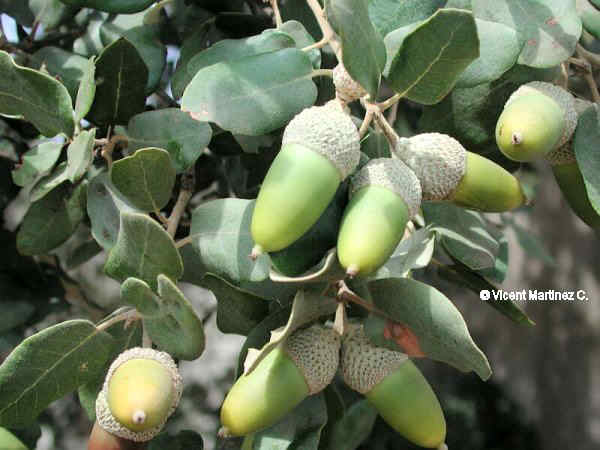 Photos of holm oak (Quercus ilex). Detail of the leaves and the fruits (acorns)
Photos of holm oak (Quercus ilex). Detail of the leaves and the fruits (acorns)
Holm oak. Propagation and care
* Propagation through seeds:
The best way to propagate oaks is through seeds. The seeds should be planted in the nursery immediately after maturing, which occurs during the autumn of the same year they have grown, although they can remain on the tree until mid-winter. Holm oak seeds should not be saved once they are mature because they lose their ability to germinate. The germination of acorns can be accelerated if they are soaked during a period of 24 hours.
In order to germinate the seeds of the oaks need low temperatures so they must be planted in seedbed to the outside, properly protected so that they are not eaten by rodents (rats, squirrels, etc.) For this we will cover the seedbed with a thick metallic mesh.
Another possibility is to plant the seed directly on the ground, although in this case, it is harder to protect from the animals. When planted in the soil they should not be planted to a depth greater than 10 cm.
* Holm oaks transplantation
If the seeds are planted in seedbeds, it is convenient to transplant them to their final place as soon as possible, that is to say when the plant has reached a span and can be easily handled without the danger of damaging its roots or leaves.
In any case, it is not advisable to leave the plant in the nursery for more than two seasons since this tree produces very deep roots and needs abundant land to develop well.
Holm oaks are trees that do not like to be transplanted so it is better to ensure their final location to not have to transplant them later.
During the first four years we will maintain the soil with adequate humidity.
* Propagation of holm oaks by means of root ball
Another way of propagating holm oaks is through seedlings purchased in nursery or produced in the same farm from seeds. Planting will take place during autumn or winter, better on cloudy and humid days. In this case we must prepare the soil to try to make an adequate hole and be careful not to spoil the roots when planting.
Also we must maintain the proper humidity during the first years so that it takes root well. (More information on how to plant a tree with a root ball)
Regardless of the method used, it must be borne in mind that holm oak is a slow-growing tree. It is estimated in about 50 years the period of time in which this tree can produce acorns.
When should holm oaks be pruned?
The pruning of holm oaks is very useful both to give them the proper form and to rejuvenate them.
Pruning should be done throughout the winter. It will be done in such a way that only thin branches should be removed. For this it is convenient to start when the tree is a couple of meters high and not let it produce old branches too large.
In this first pruning, the branches of the trunk will be eliminated and the upper branches will be cut so that the specimen will have three or four main branches and a clean interior. As it grows, it is important to only cut the dry branches or shape them by eliminating the thin material.
It is not convenient that this task be carried out every year, since it is necessary to let the trees rest for periods of 5-10 years for the lightest pruning and up to 15 or 20 years for the deepest prunings that involve leaving the inner arms in number from 3 to 6.
Also keep in mind that pruning tools must be properly sharpened and disinfected to prevent possible infections in the cut. There are a number of products on the market, such as “mastic”, which are used to cover the cut and seal the wound and prevent microorganisms from penetrating through it.
It must be borne in mind that pruning of centuries-old holm oaks is much more delicate and should only be done by a specialist. We also have to consider that in many places the holm oak or holm oaks fields are protected and that they can only be pruned with the consent of the competent authority.
It is also necessary to remove and burn the material pruned from the soil to prevent possible microorganisms from spreading to healthy trees. The legislation of many governments obliges to carry out this cleaning in case of pruning of forest trees such as holm oaks.
Holm oak soil and fertilizer
Holm oak is a very strong tree that can grow on any type of soil, except in those that have poor drainage or those of a saline or gypsum nature, although it prefers fertile, deep, light and permeable soils with a marly nature. They also accept very well sandy soils.
A fertilizer with organic matter can help improve fruit production.
![]() More information on holm oak.
More information on holm oak.


